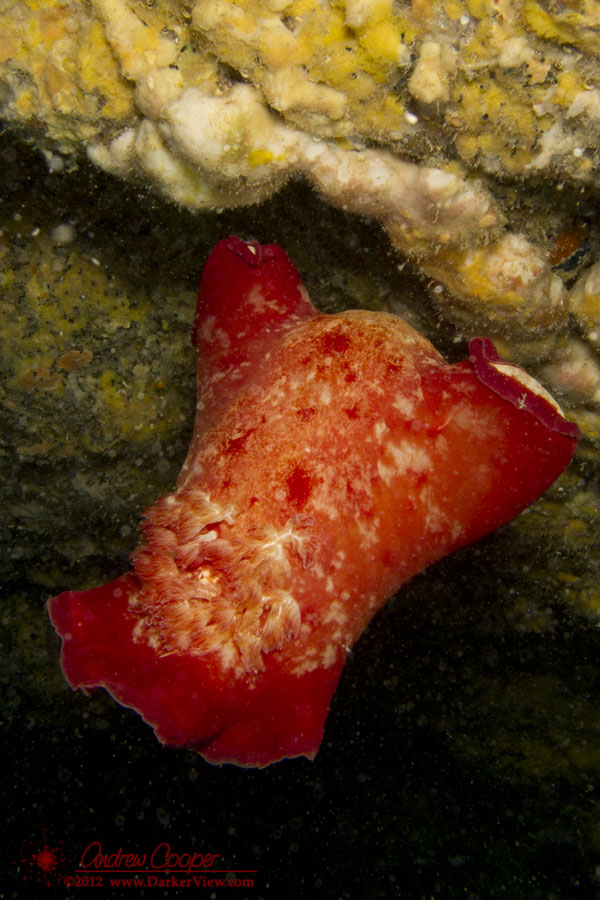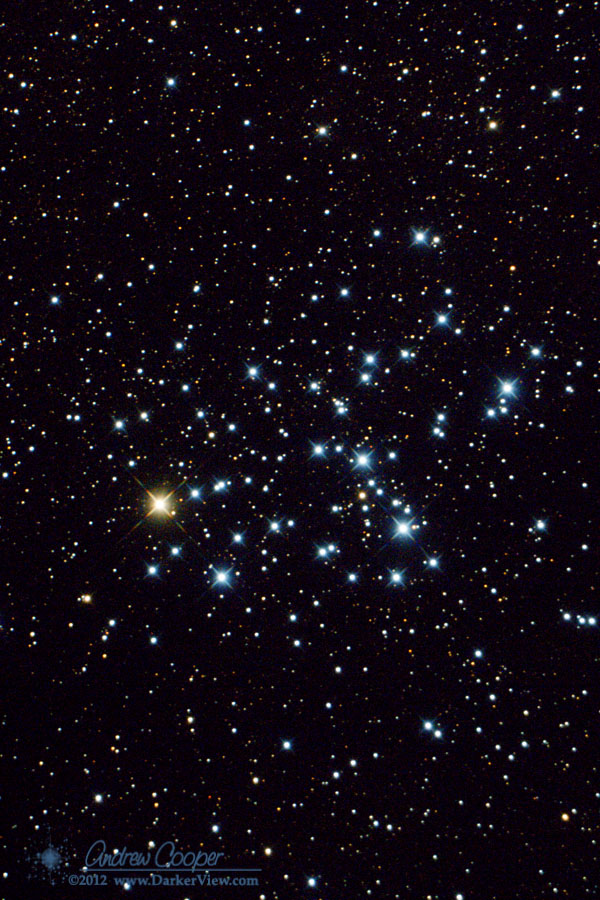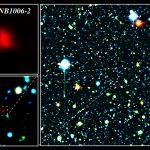
Postcard from the Reef – Spanish Dancer
What is that? That is too big to be a nudibranch, but that is what it looked like. I could only see part of the beast looking into the cave crevice. Fortunately it turned out to be somewhat photophobic, the bright light flushed it out of the crevice into the cave…

I make a point to look for nudibranchs, pretty critters that are wonderfully photogenic. Looking into the nooks and crannies of the reef for nudibranchs also tends to turn up other tiny surprises.
This was not small!
While the typical nudibranch is one or two inches long, this fellow was the size of a dinnerplate! Adding to the wonder was the dance. As soon as the animal left the crevice it swam across the cave. I flashed Mark to get his attention, he was ready to leave the cave. I suspect he is glad he came back. Deb also wondered what we were still doing in the cave and came in to check on us. Thus we all got a good look at the dance.
After a few photos… OK, a lot of photos, I shepherded the fellow back into his crevice. Once I withdrew the light he settled down to stay in the darkness.

Diving Puakō
Another weekend, another dive. This time at one of our favorite dive spots, Puakō End-of-Road. It was just Deb and I this time. The usual crew was out this weekend as well, but we had other goals in mind for the dive and choose to go to a closer site.

The other pleasant surprise was finding two new species of nudibranch. As Deb and I were diving without the rest of the crew, I was particularly slow. As usual poking my head into every nook and cranny. The result was finding examples of Phyllidiella rosans and Phyllidiopsis sphingis.
Going slow and shallow had another effect, almost 80 minutes underwater. Not a record for us, but high on the list of our longer dives. Not bad for a single aluminum 80 cylinder.
A nice Saturday dive, another hour spent underwater, and some new stuff found. A good day.
Postcard from the Universe – Butterfly Cluster
Known as M6, NGC6405, or The Butterfly Cluster, this pretty open cluster lies just above the tail of Scorpius. Visible to the unaided eye under a dark sky, it is an easy photographic target.
I have been working on improving the color balance in my astrophotos. Color is an interesting and complex subject in photography, worse in astrophotography. I think the results are much better here that in my previous work. Hope to take a few more photos this week and will continue to experiment.

Postcard from the Reef – Lizardfish
The Moon and Mercury
A very thin Moon will rendezvous with Mercury this evening. The pair will separated by about 8° and at the same elevation, over 20° at sunset. The Moon will be a very thin crescent, only 7% illuminated. A little over 5° north of Mercury will be Pollux, with Castor a bit further north, both stars about a magnitude dimmer than the planet which is currently about zero magnitude.
Discovery of the Most Distant Galaxy in the Cosmic Dawn
W. M. Keck Observatory press release…
A team of astronomers has used the Subaru Telescope and the W. M. Keck Observatory to discover the most distant galaxy yet, at 12.91 billion light-years from the Earth. This new galaxy, dubbed SXDF-NB1006-2, is slightly farther away than the previous record holder, galaxy GN-108036, which was found last year.
To identify SXDF-NB1006-2, the team used the Subaru Telescope to observe a total of 37 hours in seven nights in two wide fields of the sky. The team, led by Takatoshi Shibuya (The Graduate University for Advanced Studies, Japan), Dr. Nobunari Kashikawa (National Astronomical Observatory of Japan), Dr. Kazuaki Ota (Kyoto University), and Dr. Masanori Iye (National Astronomical Observatory of Japan), carefully processed the images they had obtained. Shibuya measured the color of 58,733 objects in the images and identified four galaxy candidates at a redshift of 7.3, which translates into about 12.9 billion light-years. A careful investigation of the brightness variation of the objects allowed the team to narrow down the number of candidates to two.
 Color composite image of the Subaru XMM-Newton Deep Survey Field of galaxy SXDF-NB1006-2, credit NAOJ
Color composite image of the Subaru XMM-Newton Deep Survey Field of galaxy SXDF-NB1006-2, credit NAOJ
Finally, the team needed to make spectroscopic observations to confirm the nature of these candidates. They observed the two galaxy candidates with two spectrographs, the Faint Object Camera and Spectrograph (FOCAS) on the Subaru Telescope and the Deep Imaging Multi-Object Spectrograph (DEIMOS) on the Keck II Telescope, and identified one candidate for which a characteristic emission line of distant galaxies could be detected. The results are slated to be published in the June 20, 2012, edition of Astrophysical Journal.
In addition to locating the galaxy, the team’s research verified that the proportion of neutral hydrogen gas in the 750-million-year-old early Universe was higher than it is today. These findings help to decipher the early Universe during the “cosmic dawn,” when the light of ancient celestial objects and structures first appeared. They concluded that about 80 percent of the hydrogen gas in the ancient Universe, 12.91 billion years ago at a redshift of 7.2, was neutral.
Continue reading “Discovery of the Most Distant Galaxy in the Cosmic Dawn”
Summer Solstice
Summer solstice occurs today at 13:09HST. Today the Sun will occupy the most northerly position in the sky of the year. The term solstice comes from the latin terms Sol (the Sun) and sistere (to stand still). On this day the Sun seems to stand still as it stops moving northwards each day and begins move to the south. This is the first day of summer as marked by many cultures in the northern hemisphere.
| 2012 Solstices and Equinoxes | ||||
|---|---|---|---|---|
| UT | HST | |||
| Perihelion | Jan 5 | 03:59UT | Jan 4 | 17:59HST |
| Spring Equinox | Mar 20 | 05:14UT | Mar 19 | 19:14HST |
| Summer Solstice | Jun 20 | 23:09UT | Jun 20 | 13:09HST |
| Apehelion | Jul 4 | 23:59UT | Jul 4 | 13:59HST |
| Fall Equinox | Sep 22 | 14:49UT | Sep 22 | 04:49HST |
| Winter Solstice | Dec 21 | 11:12UT | Dec 21 | 01:12HST |
| Source: USNO Data Services Website and the NASA Sky Calendar | ||||



